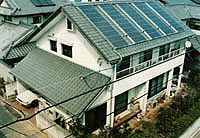|
Top Picks || Arts & Entertainment || Business & Economy || Education & Society ||
GOOD DAY SUNSHINE: Rising Use of Solar Energy for Housing September 25, 1998  Solar panels are popping up on more roofs than ever. (Jiji Press) An increasing number of home construction companies are looking to solar power as an ideal form of clean energy that does not emit greenhouse gases. The move is being pushed along by the declining price of solar power systems, which has fallen by half over the last three years and is expected to halve again in the next five to seven years. Industry sources forecast that solar power generation will grow into a market worth 1 trillion yen (7.4 billion U.S. dollars at 135 yen to the dollar) by 2010. Sharp Drop in Price The biggest obstacle to the diffusion of these generation systems is their price. Solar power systems are unavoidably expensive because of such factors as the weakness of solar energy by the time it reaches the surface of the Earth, which means solar cells must be rather large; the need to transform the generated electricity from direct to alternating current; and the need to install a supplementary system that stores the energy generated in the daytime for use at night. In 1992, when solar power started to become popular, a system that could cover the electricity requirements for a typical family of four in a detached house cost 12 million yen. Since then cells have been improved and mass production has lowered the price to about 6 million yen in 1994 and about 2.7 million yen (20,000 dollars) in 1998. With a subsidy, a family now needs about 1.8 million yen (13,300 dollars) to install a system. The electricity bill of a typical household still comes to about 75,000 yen (556 dollars) a year on average, however, so it would take 24 years to recover the cost of installation. Another step down in prices is clearly required. Leading Energy of the Future One reason for the recent growing interest in solar power generation systems is the impetus provided by the Third Conference of the Parties to the U.N. Framework Convention on Climate Change, which was held in Kyoto in December 1997. At that conference, developed countries reached agreement on the reduction and prevention of greenhouse gases, and Japan promised to reduce emissions of such gases by an average of 6% from the 1990 level during the period from 2008 to 2012. Over the last few years Japan's consumption of energy and emission of greenhouse gases have been on the rise, mainly because of increases in the household sector rather than industry. Much expectation is being placed in home solar power generation, therefore, as a key to reducing emissions overall. Solar power generation has various other merits, too. For a start, the supply of solar energy is limitless and inexhaustible. Also, there is almost no need for maintenance, which gives it an advantage over currently used thermal, hydro, and nuclear generation. And almost all experts forecast that the generation cost will drop below that of nuclear and other forms of generation in the near future. It may not be long before houses equipped with solar panels on their roofs become a common sight.
 Edited by Japan Echo Inc. based on domestic Japanese news sources. Articles presented here are offered for reference purposes and do not necessarily represent the policy or views of the Japanese Government. Edited by Japan Echo Inc. based on domestic Japanese news sources. Articles presented here are offered for reference purposes and do not necessarily represent the policy or views of the Japanese Government.
|
